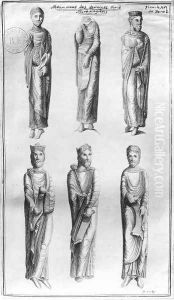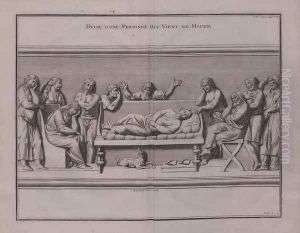Bernard de Montfaucon Paintings
Bernard de Montfaucon was a French Benedictine monk who became a highly regarded scholar and is often considered one of the founders of modern archaeology and paleography. Born on January 13, 1655, in the Langhedoc region of southern France, Montfaucon was educated at the Jesuit college in Limoux and later joined the Benedictine order in 1675 at the Abbey of Bream. He was ordained a priest in 1680.
Montfaucon's scholarly work began in earnest when he was sent to research manuscripts at various libraries across Europe. His extensive travels allowed him to examine a wide array of ancient texts, which he cataloged with meticulous care. His dedication to the study of ancient manuscripts led to significant contributions in the field of paleography, the study of ancient writing systems and the deciphering of historical manuscripts.
In 1719, Montfaucon published his most famous work, 'L'antiquité expliquée et représentée en figures' (Antiquity Explained and Represented in Figures), a comprehensive collection of engravings of ancient artifacts. This ten-volume work was instrumental in promoting the study of classical antiquity and is considered a precursor to the field of archaeology. It was among the first to illustrate artifacts in a systematic and comparative manner, providing an invaluable resource for scholars and helping to popularize the study of ancient cultures in Europe.
Montfaucon's other notable works include 'Palaeographia Graeca' (1708), which laid the foundation for Greek paleography, and 'Bibliotheca Coisliniana' (1715), a catalog of the Greek manuscripts in the collection of Henri-Charles de Coislin. His scholarship earned him membership in prestigious societies, including the Académie des Inscriptions et Belles-Lettres in Paris.
Bernard de Montfaucon continued his scholarly work until his death on December 21, 1741, at the age of 86. His legacy endures in the fields of archaeology, paleography, and the study of antiquity, and his systematic approach to cataloging and interpreting ancient texts and artifacts has had a lasting impact on the humanities.

